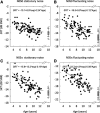Speech Recognition Abilities in Normal-Hearing Children 4 to 12 Years of Age in Stationary and Interrupted Noise
- PMID: 29554035
- PMCID: PMC7664447
- DOI: 10.1097/AUD.0000000000000569
Speech Recognition Abilities in Normal-Hearing Children 4 to 12 Years of Age in Stationary and Interrupted Noise
Abstract
Objectives: The main purpose of this study was to examine developmental effects for speech recognition in noise abilities for normal-hearing children in several listening conditions, relevant for daily life. Our aim was to study the auditory component in these listening abilities by using a test that was designed to minimize the dependency on nonauditory factors, the digits-in-noise (DIN) test. Secondary aims were to examine the feasibility of the DIN test for children, and to establish age-dependent normative data for diotic and dichotic listening conditions in both stationary and interrupted noise.
Design: In experiment 1, a newly designed pediatric DIN (pDIN) test was compared with the standard DIN test. Major differences with the DIN test are that the pDIN test uses 79% correct instead of 50% correct as a target point, single digits (except 0) instead of triplets, and animations in the test procedure. In this experiment, 43 normal-hearing subjects between 4 and 12 years of age and 10 adult subjects participated. The authors measured the monaural speech reception threshold for both DIN test and pDIN test using headphones. Experiment 2 used the standard DIN test to measure speech reception thresholds in noise in 112 normal-hearing children between 4 and 12 years of age and 33 adults. The DIN test was applied using headphones in stationary and interrupted noise, and in diotic and dichotic conditions, to study also binaural unmasking and the benefit of listening in the gaps.
Results: Most children could reliably do both pDIN test and DIN test, and measurement errors for the pDIN test were comparable between children and adults. There was no significant difference between the score for the pDIN test and that of the DIN test. Speech recognition scores increase with age for all conditions tested, and performance is adult-like by 10 to 12 years of age in stationary noise but not interrupted noise. The youngest, 4-year-old children have speech reception thresholds 3 to 7 dB less favorable than adults, depending on test conditions. The authors found significant age effects on binaural unmasking and fluctuating masker benefit, even after correction for the lower baseline speech reception threshold of adults in stationary noise.
Conclusions: Speech recognition in noise abilities develop well into adolescence, and young children need a more favorable signal-to-noise ratio than adults for all listening conditions. Speech recognition abilities in children in stationary and interrupted noise can accurately and reliably be tested using the DIN test. A pediatric version of the test was shown to be unnecessary. Normative data were established for the DIN test in stationary and fluctuating maskers, and in diotic and dichotic conditions. The DIN test can thus be used to test speech recognition abilities for normal-hearing children from the age of 4 years and older.
Conflict of interest statement
The authors have no conflicts of interest to disclose.
Figures





Similar articles
-
A comparison between the Dutch and American-English digits-in-noise (DIN) tests in normal-hearing listeners.Int J Audiol. 2016;55(6):358-65. doi: 10.3109/14992027.2015.1137362. Epub 2016 Mar 4. Int J Audiol. 2016. PMID: 26940045
-
Speech Recognition in Noise Using Binaural Diotic and Antiphasic Digits-in-Noise in Children: Maturation and Self-Test Validity.J Am Acad Audiol. 2021 May;32(5):315-323. doi: 10.1055/s-0041-1727274. Epub 2021 Aug 10. J Am Acad Audiol. 2021. PMID: 34375996
-
Development of the Listening in Spatialized Noise-Sentences Test (LISN-S).Ear Hear. 2007 Apr;28(2):196-211. doi: 10.1097/AUD.0b013e318031267f. Ear Hear. 2007. PMID: 17496671
-
How linguistic closure and verbal working memory relate to speech recognition in noise--a review.Trends Amplif. 2013 Jun;17(2):75-93. doi: 10.1177/1084713813495459. Epub 2013 Aug 13. Trends Amplif. 2013. PMID: 23945955 Free PMC article. Review.
-
The digit triplet test: a scoping review.Int J Audiol. 2021 Dec;60(12):946-963. doi: 10.1080/14992027.2021.1902579. Epub 2021 Apr 11. Int J Audiol. 2021. PMID: 33840339
Cited by
-
Development and validation of a digits-in-noise hearing test in Persian.Int J Audiol. 2021 Mar;60(3):202-209. doi: 10.1080/14992027.2020.1814969. Epub 2020 Sep 9. Int J Audiol. 2021. PMID: 32903129 Free PMC article.
-
Masked Speech Recognition by Normal-Hearing 6-13-Year-Olds in Conditions With and Without Interaural Difference Cues.Trends Hear. 2022 Jan-Dec;26:23312165221137117. doi: 10.1177/23312165221137117. Trends Hear. 2022. PMID: 36452987 Free PMC article.
-
Improved Sensitivity of Digits-in-Noise Test to High-Frequency Hearing Loss.Ear Hear. 2021 May/Jun;42(3):565-573. doi: 10.1097/AUD.0000000000000956. Ear Hear. 2021. PMID: 33928924 Free PMC article.
-
A pilot study on spatial hearing in children with congenital unilateral aural atresia.Front Pediatr. 2023 Aug 9;11:1194966. doi: 10.3389/fped.2023.1194966. eCollection 2023. Front Pediatr. 2023. PMID: 37622080 Free PMC article.
-
Genotype and Phenotype Analyses of a Novel WFS1 Variant (c.2512C>T p.(Pro838Ser)) Associated with DFNA6/14/38.Genes (Basel). 2023 Feb 10;14(2):457. doi: 10.3390/genes14020457. Genes (Basel). 2023. PMID: 36833385 Free PMC article.
References
-
- Bernstein J. G., Grant K. W. Auditory and auditory-visual intelligibility of speech in fluctuating maskers for normal-hearing and hearing-impaired listeners. J Acoust Soc Am, 2009). 125, 3358–3372.. - PubMed
-
- Cameron S., Dillon H. Development of the listening in spatialized noise-sentences test (LISN-S). Ear Hear, 2007). 28, 196–211.. - PubMed
-
- Cameron S., Brown D., Keith R., et al. Development of the North American Listening in Spatialized Noise-Sentences test (NA LiSN-S): Sentence equivalence, normative data, and test-retest reliability studies. J Am Acad Audiol, 2009). 20, 128–146.. - PubMed
Publication types
MeSH terms
LinkOut - more resources
Full Text Sources
Other Literature Sources
Medical
Miscellaneous

